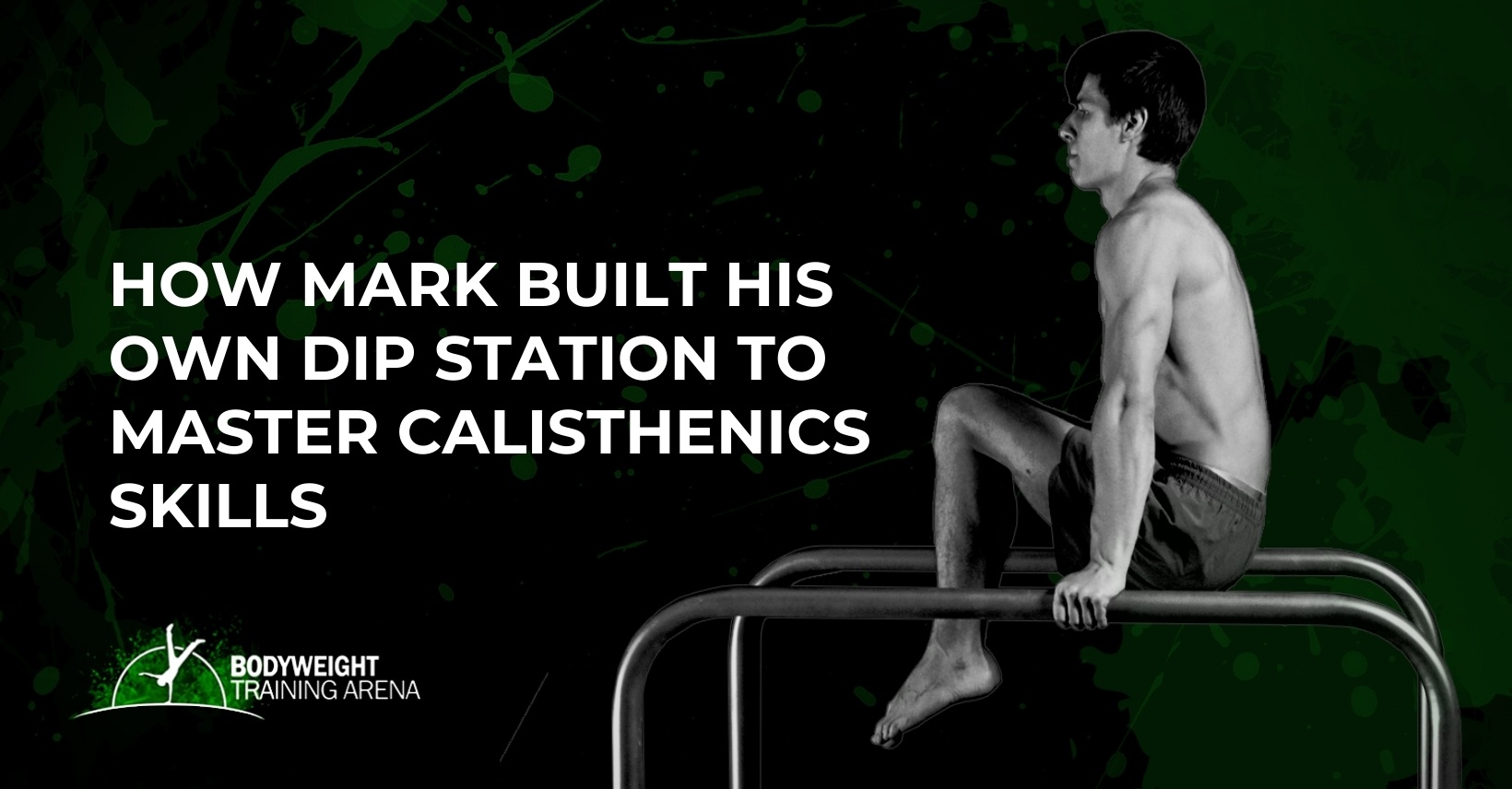
Join the tribe of Movement & Calisthenics Athlete - people just like you that are working with their own body weight to get strength, lose fat build muscle, recover from injuries and live their best lives!
A calisthenics workout can be done without any equipment, but I knew that if I wanted to expand my list of available exercises and progress without adding weight lifting to the mix, I needed at least some equipment other than just the wall.
Read more: Ultimate calisthenics equipment guide & accessible alternatives
A dip station is a piece of equipment that opens up to a more comprehensive calisthenics routine. A dip bar will allow you to perform dips and pull-ups while avoiding the need for some major investments like a gym membership or expensive equipment.
Why get a horizontal dip bar/ pull-up bar?

The horizontal dip bar is perfect for many exercises you can work with other than the obvious, dips. Here’s a quick rundown on why you need to get a pair of these!
- A single piece can use be used for chin-ups, inverted rows, or straight dip bar
- Two pieces can act as parallel bars
- Applicable for multiple exercises such as push-ups, l-sits, planches, handstands, etc for a variety of workout goals.
Buying a build could be expensive
A while back, I wanted to buy a set of Horizontal bars. But in Canada, their price can be anywhere between CAD $100 and $300.For example, I looked at the Lebert Equalizer. You can see it in Frank Medrano’s Youtube videos, and boy did I want them! There are other brands and whatnot, but these were the ones I wanted the most.
I priced out how much it would cost to buy them. And because of their price, I started to think, “Hey…Maybe I can make my own!”
Why make a Homemade dip station?
I decided to build dip bars on my own. It might sound like a daunting task but it’s actually very easy to do.
Here’s a brief on why you can opt for building your own set of dip bars:
Fits any budget
Depending on how much budget you would want to set for your DIY dip bars, you can get a set that you paid for. Either you can save more or spend more to get a sturdier, more personalized, and customized dip bar.
Want to save more? Use reclaimed wood, wood boards, and scraps of PVC. Just make sure to choose carefully the sturdiest option.
Want to spend more? Get the best option of steel available, design a structure that fits better your specification that even most gyms would love to buy!
Can be easily adjusted as you get stronger
You can first just start off with a lighter set of dip bars. As you get more upper body strength and tend to move to weighted calisthenics, you can build a sturdier homemade dip station that can carry more than just your body weight.
Build your own home gym
No need to buy equipment that’s currently expensive and difficult to find in Canada (Canada is a small market)
And so I have made my own dip station. A DIY Dip Bar! And it cost me less than $100 and is also good for a variety of exercises.
Create an awesome sense of accomplishment
Building your own gym is an amazing accomplishment itself.
Easy to assemble
Creating this project isn’t that hard. You just need to prepare the frame of the structure, connect one end to the other end, cover the open end, and add a material underneath the base for grip to avoid slippage.
How to build dip station at home for under 100 USD
I can tell you right now how easy it is and stress-free creating this DIY dip bar for my home gym. No need for a measuring tape or any advanced skills in craftsmanship is needed.
My adventure to build my own horizontal bar started.
I wrote out a rough project plan on how I wanted to build it, inspired by my doorway pull-up bar.
My goal with my new bar is to get better at my pulling mechanics and dips, so I used the measurements of my pull-up bar.
The idea was simple.
I wanted to keep it light and movable, while still being strong and solid. I knew I wanted the parts I’d hold to be round.
I played with the idea of making the base out of wood, but that would make it bulky and heavy. Wood tends to be more high-maintenance and expensive for sturdier options. So I ended up deciding to use some kind of plumbing pipe for the bars, stand, and base instead.
A trip to the hardware store!
I went exploring and found some fencing poles, but I could neither find 90-degree bends or T-joints here. It was sad because Fence poles are dirt-cheap (CAD $3 for 8 FEET)
PVC pipe vs steel pipe
There are many different options to choose from when building your own dip station, but PVC pipes are a more affordable option. If you’re looking for steel pipes then expect to pay about three times as much; however, this doesn’t mean it’s not worth considering. Steel is heavy duty and will last longer. It can be transported around easily as well.
I thought of using copper because it’d look nice, but it was too expensive and way too soft a metal for what I wanted to do. I settled for a black pipe in the end. Many people have used black pipes for their DIY pull-up bar and homemade dip bars.
I still didn’t know if it’d be stable enough to be a stand, but hey, nothing tried, nothing gained, right?
Also, they were very affordable for me. Not even CAD $2/foot!
Apparently, black ones are normally used for gas lines. So it’s pretty solid stuff.
How long should it be?
As I was shopping at the store, my idea became clearer and clearer. I knew I wanted a bar about 30 inches across. The distance was based on my shoulder width.
How high should it be?
I figured 30 inches in height would also be good to achieve for my purpose and within my ideal total cost, but this varies from person to person and the workout you intended to do. I just wanted something I can do my rows while still be able to do chin-ups and dips while my feet are off the ground by adjusting my legs. The height is up to you.
So here’s the list of materials I used after all my deep thinking:
- 3 pcs – 30-inch length black PVC pipe, threaded both sides
- 4 pcs – 8-inch length black pipes, threaded one side
- 2 pcs- 90-degree bend
- 2 pcs – T joint connector
You don’t need to bring a tape measure. Just ask for help in your local store for the measurements. Once you’ve bought the material, have all the ends of the pipe threaded, if it isn’t already.

This is a threaded screw. The striations on it were made by a machine to connect it to the different parts without the need for PVC glue or other adhesives.
When you buy plumbing pipes in a store, they’re not always threaded. So you can pay to have it done in the store, or you can just buy pipes that are pre-threaded.
Fitting them together
All that’s left after that is fitting the different parts together! Here’s mine:

Simplicity
As I mentioned earlier, building dip bars isn’t rocket science. The design is very simple enough to know where to put in which holes and fit the other side to another.
The next thing you know, you now have top bars ready for use for your calisthenics journey!
Base stability
You might be asking, “But Mark, what’s that white tape on the end of the base?”
Well! glad you asked.
Lucky for me the local sporting store was closing down, so that tape is Hockey Tape! I got a bunch for less than CAD $5.
The T’s on the feet were making the bar rock back and forth, so I bought end caps, which made them more stable.
Although I didn’t like the idea of adding more weight to it or that metal on a wood flooring doesn’t normally do well…for the floor. So I wrapped the bottom legs to get some grip and stability. This has helped the stability tremendously!
After a few uses, the tape kind of flattens out and becomes a perfect landing for the bar. I’m sure any kind of grip tape would work just the same.
If you feel like spending a bit more, you can add floor flanges for the base and use non-slip material underneath, but you need to buy another set of 90’s for
Inexpensive materials
It was super simple and cost me CAD $50 for all the parts. I’d have saved $15 had I wanted to thread the pipes myself, but I chose to pay for it instead.
Just so you know, most big box stores do that for free.
I chose to make 30×30”, but next time I make them myself, I’ll be fitting them to my height of 5’5” – it’d be nicer if I could reach the bar while laying on the ground, flat on my back.
If you want to custom tailor your horizontal DIY dip bar, I suggest that you measure your arm length and add 1-2 inches to get a perfect fit in height.
I’d also suggest you use 10-inch pipes for the “feet” or base. It’ll be a bit more stable than my first creation.
With that said, I love it!

So that’s my custom built Horizontal Bar.
I’m probably not done making my own custom fitness equipment after this first one! So keep your eyes open, you’ll be seeing more from me.
DIY dip station and pull-up bar in one!
If you make a second horizontal bar, BAM! you have your own dip station
To wrap it up!
You don’t have to spend a fortune on your calisthenics equipment. It just takes a trip down to your hardware store, and the rest is just like assembling a toy.
Now you can boost your calisthenics upper body gains at the comforts of your own home
If you want to try building your own horizontal bar and have questions, leave a comment or shoot me a message in the Facebook group!



